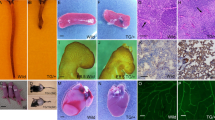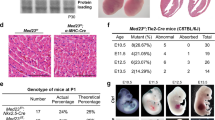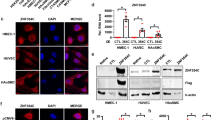Abstract
We show that the transcriptional repressor Tel plays an evolutionarily conserved role in angiogenesis: it is indispensable for the sprouting of human endothelial cells and for normal development of the Danio rerio blood circulatory system. Tel orchestrates endothelial sprouting by binding to the generic co-repressor, CtBP. The Tel–CtBP complex temporally restricts a VEGF (vascular endothelial growth factor)-mediated pulse of dll4 expression and thereby directly links VEGF receptor intracellular signalling and intercellular Notch–Dll4 signalling. It further controls branching by regulating expression of other factors that constrain angiogenesis such as sprouty family members and ve-cadherin. Thus, the Tel–CtBP complex conditions endothelial cells for angiogenesis by controlling the balance between stimulatory and antagonistic sprouting cues. Tel control of branching seems to be a refinement of invertebrate tracheae morphogenesis that requires Yan, the invertebrate orthologue of Tel. This work highlights Tel and its associated networks as potential targets for the development of therapeutic strategies to inhibit pathological angiogenesis.
This is a preview of subscription content, access via your institution
Access options
Subscribe to this journal
Receive 12 print issues and online access
$209.00 per year
only $17.42 per issue
Buy this article
- Purchase on Springer Link
- Instant access to full article PDF
Prices may be subject to local taxes which are calculated during checkout







Similar content being viewed by others
Accession codes
References
Phng, L.-K. & Gerhardt, H. Angiogenesis: a team effort coordinated by Notch. Developmental Cell 16, 196–208 (2009).
Gerhardt, H. VEGF and endothelial guidance in angiogenic sprouting. Organogenesis 4, 241–246 (2008).
Carmeliet, P. et al. Abnormal blood vessel development and lethality in embryos lacking a single VEGF allele. Nature 380, 435–439 (1996).
Ferrara, N. et al. Heterozygous embryonic lethality induced by targeted inactivation of the VEGF gene. Nature 380, 439–442 (1996).
Gerhardt, H. VEGF guides angiogenic sprouting utilizing endothelial tip cell filopodia. J. Cell Biol. 161, 1163–1177 (2003).
Hellstrom, M. et al. Dll4 signalling through Notch1 regulates formation of tip cells during angiogenesis. Nature 444, 776–780 (2006).
Tammela, T. et al. Blocking VEGFR-3 suppresses angiogenic sprouting and vascular network formation. Nature 454, 656–660 (2008).
Krebs, L. T. et al. Notch signaling is essential for vascular morphogenesis in mice. Genes Dev. 14, 1343–1352 (2000).
Ruhrberg, C. et al. Spatially restricted patterning cues provided by heparin-binding VEGF-A control blood vessel branching morphogenesis. Genes Dev. 16, 2684–2698 (2002).
Noguera-Troise, I. et al. Blockade of Dll4 inhibits tumour growth by promoting non-productive angiogenesis. Nature 444, 1032–1037 (2006).
Leslie, J. D. et al. Endothelial signalling by the Notch ligand Delta-like 4 restricts angiogenesis. Development 134, 839–844 (2007).
Hogan, B. M. et al. VEGFC/Flt4 signalling is suppressed by Dll4 in developing zebrafish intersegmental arteries. Development 36, 4001–4009 (2009).
Bahary, N. et al. Duplicate VegfA genes and orthologues of the KDR receptor tyrosine kinase family mediate vascular development in the zebrafish. Blood 15, 3627–3636 (2007).
Siekmann, A. F. & Lawson, N. D. Notch signalling limits angiogenic cell behaviour in developing zebrafish arteries. Nature 445, 781–784 (2007).
Liu, Z.-J. et al. Regulation of Notch1 and Dll4 by vascular endothelial growth factor in arterial endothelial cells: implications for modulating arteriogenesis and angiogenesis. Mol. Cell Biol. 23, 14–25 (2003).
Ridgway, J. et al. Inhibition of Dll4 signalling inhibits tumor growth by deregulating angiogenesis. Nature 444, 1083–1087 (2006).
Sainson, R. C. A. et al. Cell-autonomous notch signaling regulates endothelial cell branching and proliferation during vascular tubulogenesis. FASEB J. 19, 1027–1029 (2005).
Ruhrberg, C. Growing and shaping the vascular tree: multiple roles for VEGF. Bioessays 25, 1052–1060 (2003).
Gale, N. W. et al. Haploinsufficiency of delta-like 4 ligand results in embryonic lethality due to major defects in arterial and vascular development. Proc. Natl Acad. Sci. USA 101, 15949–15954 (2004).
Duarte, A. et al. Dosage-sensitive requirement for mouse Dll4 in artery development. Genes Dev. 18, 2474–2478 (2004).
Siekmann, A. F., Covassin, L. & Lawson, N. D. Modulation of VEGF signaling output by the Notch pathway. Bioassays 30, 303–313 (2008).
Lobov, I. B. et al. Delta-like ligand 4 (Dll4) is induced by VEGF as a negative regulator of angiogenic sprouting. Proc. Natl Acad. Sci. USA 104, 3219–3224 (2007).
Suchting, S. et al. The Notch ligand Delta-like 4 negatively regulates endothelial tip cell formation and vessel branching. Proc. Natl. Acad. Sci. USA 104, 3225–3230 (2007).
Ghabrial, A., Luschnig, S., Metzstein, M. M. & Krasnow, M. A. Branching morphogenesis of the Drosophila tracheal system. Annu. Rev. Cell Dev. Biol. 19, 623–647 (2003).
Ghabrial, A. & Krasnow, M. A. Social interactions among epithelial cells during tracheal branching morphogenesis. Nature 441, 746–749 (2006).
Brunner, D. et al. The ETS domain protein pointed-P2 is a target of MAP kinase in the sevenless signal transduction pathway. Nature 370, 386–389 (1994).
Rebay, I. & Rubin, G. M. Yan functions as a general inhibitor of differentiation and is negatively regulated by activation of the Ras1/MAPK pathway. Cell 80, 857–866 (1995).
Hacohen, N., Kramer, S., Sutherland, D., Hiromi, Y. & Krasnow, M. A. sprouty encodes a novel antagonist of FGF signaling that patterns apical branching of the Drosophila airways. Cell 92, 253–263 (1998).
Ikeya, T. & Hayashi, S. Interplay of Notch and FGF signaling restricts cell fate and MAPK activation in the Drosophila trachea. Development 126, 4455–4463 (1999).
Golub, T. R., Barker, G. F., Lovett, M. & Gilliland, D. G. Fusion of PDGF receptor beta to a novel Ets-like gene, tel, in chronic myelomonocytic leukemia with t(5;12) chromosomal translocation. Cell 77, 307–316 (1994).
Wang, L. C. et al. Yolk sac angiogenic defect and intra-embryonic apoptosis in mice lacking the Ets-related factor TEL. EMBO J. 16, 4374–4383 (1997).
Lopez, R. G. et al. TEL is a sequence-specific transcriptional repressor. J. Biol. Chem. 274, 30132–30138 (1999).
Roukens, M. G. et al. Identification of a new site of sumoylation on Tel (ETV6) uncovers a PIAS-dependent mode of regulating Tel function. Mol. Cell Biol. 28, 2342–2357 (2008).
Roukens, M. G., Alloul-Ramdhani, M., Moghadasi, S., Op den Brouw, M. & Baker, D. A. Downregulation of vertebrate Tel (ETV6) and Drosophila Yan is facilitated by an evolutionarily conserved mechanism of F-box-mediated ubiquitination. Mol. Cell Biol. 28, 4394–4406 (2008).
Chinnadurai, G. Transcriptional regulation by C-terminal binding proteins. Int. J. Biochem. Cell Biol. 39, 1593–1607 (2007).
Nakatsu, M. N. & Hughes, C. C. W. An optimized three-dimensional in vitro model for the analysis of angiogenesis. Methods Enzymol. 443, 65–82 (2008).
Hildebrand, J. D. & Soriano, P. Overlapping and unique roles for C-terminal binding protein 1 (CtBP1) and CtBP2 during mouse development. Mol. Cell Biol. 22, 5296–5307 (2002).
Schaeper, U. et al. Molecular cloning and characterization of a cellular phosphoprotein that interacts with a conserved C-terminal domain of adenovirus E1A involved in negative modulation of oncogenic transformation. Proc. Natl. Acad. Sci. USA 92, 10467–10471 (1995).
Turner, J. & Crossley, M. The CtBP family: enigmatic and enzymatic transcriptional co-repressors. BioEssays 23, 683–690 (2001).
Soderberg, O. et al. Direct observation of individual endogenous protein complexes in situ by proximity ligation. Nat. Methods 3, 995–1000 (2006).
Nardini, M. et al. CtBP/BARS: a dual-function protein involved in transcription co-repression and Golgi membrane fission. EMBO J. 22, 3122–3130 (2003).
Zhao, L.-J., Subramanian, T., Zhou, Y. & Chinnadurai, G. Acetylation by p300 regulates nuclear localization and function of the transcriptional corepressor CtBP2. J. Biol. Chem. 281, 4183–4189 (2006).
Zhang, Q., Piston, D. W. & Goodman, R. H. Regulation of corepressor function by nuclear NADH. Science 295, 1895–1897 (2002).
Benedito, R. et al. The Notch ligands Dll4 and Jagged1 have opposing effects on angiogenesis. Cell 137, 1124–1135 (2009).
Cabrita, M. A. & Christofori, G. Sprouty proteins, masterminds of receptor tyrosine kinase signaling. Angiogenesis 11, 53–62 (2008).
Vestweber, D. VE-cadherin: the major endothelial adhesion molecule controlling cellular junctions and blood vessel formation. Arterioscler. Thromb. Vasc. Biol. 28, 223–232 (2008).
Lawson, N. D. & Weinstein, B. M. In vivo imaging of embryonic vascular development using transgenic zebrafish. Dev. Biol. 248, 307–318 (2002).
Isogai, S., Lawson, N. D., Torrealday, S., Horiguchi, M. & Weinstein, B. M. Angiogenic network formation in the developing vertebrate trunk. Development 130, 5281–5290 (2003).
Acknowledgements
We thank members of the Department of Molecular Cell Biology and the Schulte-Merker laboratory for helpful discussions. We would particularly like to thank P. Meier, P. ten Dijke, E. Meulmeester and M. Goncalves for critical reading of the manuscript. We are indebted to G. Chinnadurai for the human CtBP plasmids, S. Parkhurst for the Drosophila CtBP plasmid and antibody and Genentech for providing their neutralizing anti-Dll4 antibody16. We thank E. Bos for assistance with the culture of HUVECs and L. Hawinkels for providing primary tumour sections and, together with L. Pardali, for advice on the immunohistochemistry experiments. We are indebted to F. Bos for help and advice with microscopy. We are grateful to J. Oosting for the analyses of the microarray data and A. van der Laan for help with the confocal microscopy.
Author information
Authors and Affiliations
Contributions
M.G.R. performed most of the experiments assisted by M.A.R. and D.A.B. B.B. performed PLA experiments assisted by H. v.D. K.K. isolated and cultured fresh primary HUVECs. J. P.-M. and S. S.-M. helped design and perform experiments described in Figure 7. S. S.-M. provided reagents, essential technical expertise and intellectual input. D.A.B. conceived the project, designed the experiments with M.G.R. and wrote the paper assisted by M.G.R.
Corresponding author
Ethics declarations
Competing interests
The authors declare no competing financial interests.
Supplementary information
Supplementary Information
Supplementary Figures 1–10 (PDF 2147 kb)
Rights and permissions
About this article
Cite this article
Roukens, M., Alloul-Ramdhani, M., Baan, B. et al. Control of endothelial sprouting by a Tel–CtBP complex. Nat Cell Biol 12, 933–942 (2010). https://doi.org/10.1038/ncb2096
Received:
Accepted:
Published:
Issue Date:
DOI: https://doi.org/10.1038/ncb2096
This article is cited by
-
Activation of E-prostanoid 3 receptor in macrophages facilitates cardiac healing after myocardial infarction
Nature Communications (2017)
-
ETS transcription factors in embryonic vascular development
Angiogenesis (2016)
-
CtBP1 Overexpression in Keratinocytes Perturbs Skin Homeostasis
Journal of Investigative Dermatology (2014)
-
Protein kinase D2 and heat shock protein 90 beta are required for BCL6-associated zinc finger protein mRNA stabilization induced by vascular endothelial growth factor-A
Angiogenesis (2013)



